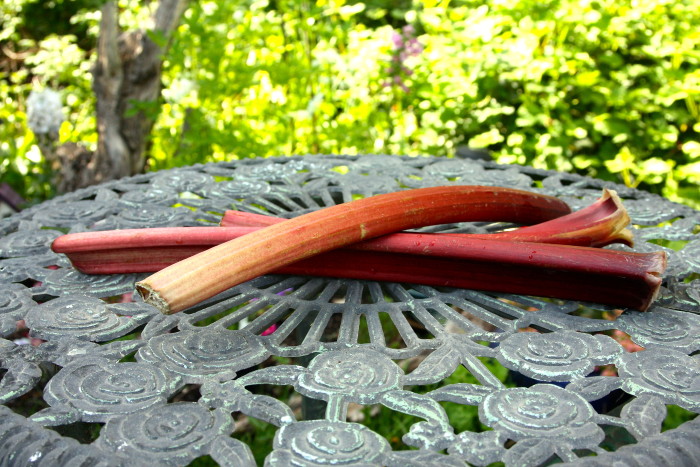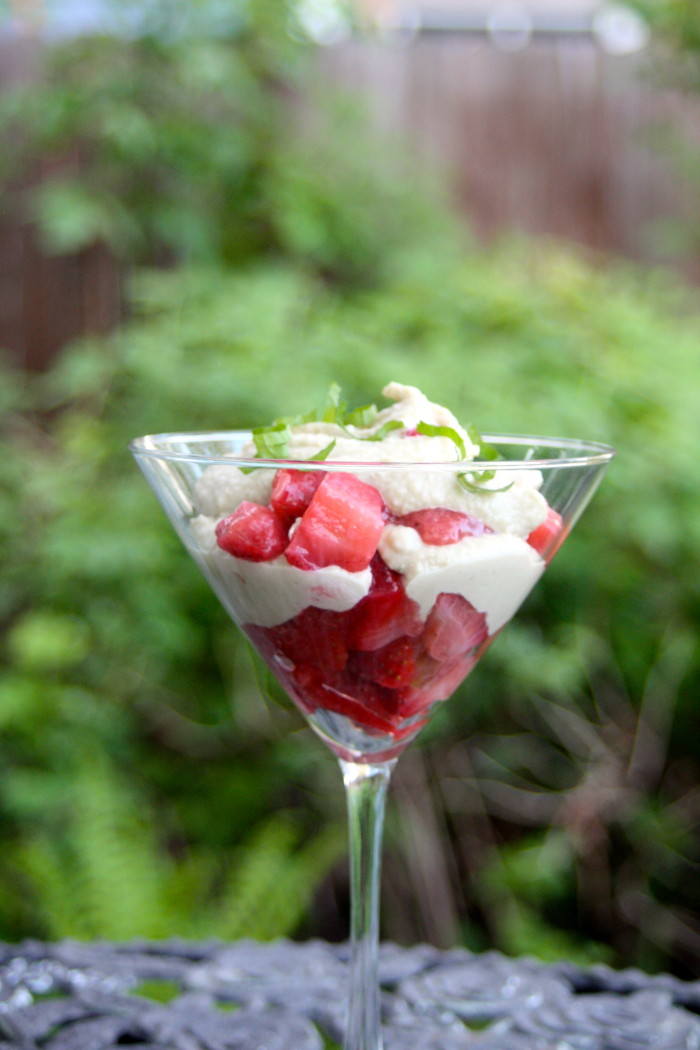
What is it?
Rhubarb is one of the first perennial vegetables that starts to grow in the spring. It is grown for the crisp and tart stalk (petiole) that attaches it’s large leaves to the rootstalk, or rhizome underground. Though the thick stalk is edible, the leaves are high in oxalic acid which is toxic. Stalks that have been damaged by the cold should not be eaten because the oxalic acid from the leaves migrates down to the stalks in such conditions. This is particularly interesting because rhubarb is native to Siberia, where extreme cold is the norm.
Rhubarb is notorious for the huge size it can achieve in the garden. Rhubarb in the garden is one of the easiest vegetables to grow, but keep in mind that it can grow to a diameter of up to 6 feet! It is very prolific so be prepared to freeze a lot of rhubarb or give some to neighbors.
Most of the time rhubarb is pictured as deep red, but stalks could range in color from light green, to pink, to red. Most rhubarb grown outdoors will be green, as red and pink rhubarb varieties are grown in dark, damp sheds and harvested by candlelight. Redder varieties of rhubarb are also more tender and less fibrous-y than the green garden variety rhubarb.
Why should you eat it?
Rhubarb is high in B-vitamins such as thiamin, vitamin B-6, niacin, folates, and riboflavin. These vitamins contribute to healthy hair, skin, and liver, reduced water retention, lower cholesterol levels, improved mental function, and protection from free radicals. Red color stalks are higher in Vitamin A than paler stalks. As with most vegetables, rhubarb has a low calorie content. As with all vegetables, rhubarb has no saturated fat or cholesterol.
The stalks are also high in Vitamin K, which has potential to help strengthen bones and prevent osteoporosis. Vitamin K also limits neural damage and is prevalent in the treatment of Alzheimer’s disease.
How do you prepare it?
Rhubarb is very tart so it is usually prepared with some sort of sweetener. While most people use cane sugar, the recipe below sweetens the rhubarb with strawberries and pure apple juice. Rhubarb breaks down when it cooks so it makes for a good jam, compote, or pie filling. An important thing to remember when working with rhubarb is that it can have a fibrous-y outer layer that must be removed or else whatever you’re making will be all stringy. I’ve found that the easiest way to do this is to slice up the rhubarb, but don’t push the knife all the way through the stalk. You will end up with bunches of sliced rhubarb stalk that are held together by a thick fibrous layer which you can then peel off. Don’t worry about getting all the strings, as long as you can remove the larger, thicker fibers you’ll be okay.
Make a Soup:
Combine celery, carrots, parsley and onion on the stove top and cook for 5 minutes. Add chopped rhubarb and cook for an additional 3 minutes. Add vegetable broth and cook for 35 minutes. Puree lentils and add to the rhubarb mixture. Season and enjoy!
Poach Rhubarb:
In a small saucepan mix lemon juice, cinnamon, cloves, vanilla bean, ginger, wine, whatever else sounds good! Bring to a boil and reduce heat to low. Add rhubarb (cut into 3 inch spears) and simmer for 4 or 5 minutes, or until rhubarb is barely tender and beginning to break down.
How do you store it?
To store rhubarb without plastic, put stalks in a container of water, like a flower bouquet. Rhubarb should stay good this way for up to 4 or 5 days.
Try out this yummy recipe!
Strawberry Rhubarb Compote with Cashew Cream

Serves 4-6
This is one of my all time favorite desserts! I have also been know to eat this for breakfast, lunch, and dinner – that’s how good it is for you! First of all, what is compote? Compote is pretty much like jam, except that the fruit pieces are kept intact rather than breaking down all the way into jam. Usually sugar or corn syrup is used to sweeten compote, but this recipe uses apple juice. The idea is pretty simple. Blend cashews, maple syrup, and hot (just boiled) apple juice. Set aside to cool for an hour (refrigerate if you can). While the cashew cream is cooling, chop up the strawberries, clean and chop the rhubarb, and get the compote going. Boil rhubarb pieces in apple juice, add thickener, remove from heat and mix in strawberries and vanilla. Layer with cashew cream and enjoy! This recipe is adapted from my all time favorite cookbook Clean Food by Terry Walters, with all seasonal, vegan, and gluten-free recipes.
Cashew Cream
2 cups raw or lightly toasted cashews
1.5 cups apple juice
3 tbsp maple syrup
Bring apple juice to a boil. In the meantime, add cashews and maple syrup to a food processor. When the apple juice has boiled, slowly add to the food processor while it is running. You may not need all the apple juice. Run the food processor until the cashew cream is your desired consistency. For me this take 2-3 minutes. Allow the cashew cream to cool for at least an hour (put in fridge once it’s not too hot).
Strawberry Rhubarb Compote
2 cups chopped rhubarb
1 cup apple juice, divided into 1/2 cups
4 cups strawberries, chopped to desired size (I like mine to be about 1/2 inch big)
2 tbsp arrowroot powder
1 tsp vanilla
Add rhubarb to a large saucepan with 1/2 cup apple juice. Bring juice to a boil, reduce heat slightly, and continue cooking until rhubarb breaks down. You may need to add a little more apple juice to keep the mixture from sticking. In the meantime, dissolve arrowroot powder in the other 1/2 cup apple juice. Add to rhubarb in the saucepan and stir until everything is incorporated and the mixture begins to thicken. Remove from heat and mix in vanilla and strawberries. Layer with cashew cream and garnish with mint. Delicious!
How do you like to eat rhubarb? Please share!
Also by Bethany: Benefits of Kohlrabi + Creamy Spring Kohlrabi Soup!
Benefits of Beets + 3 Creative Recipes
__
Photo: Bethany Cox
